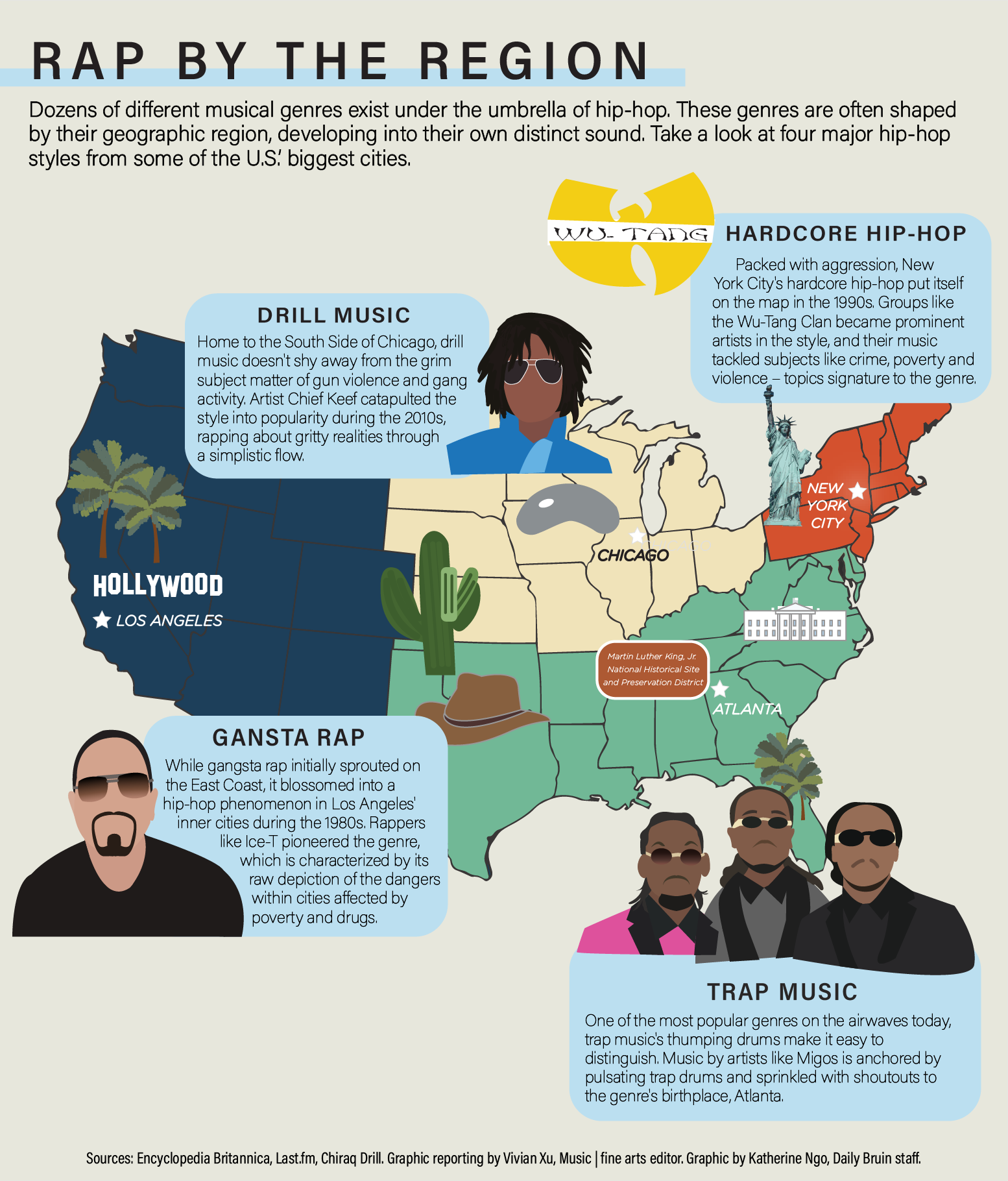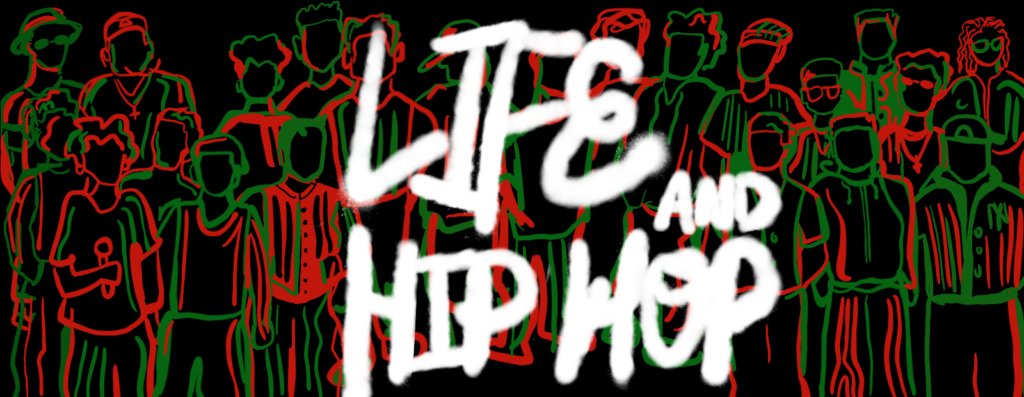Life and Hip-Hop: Artists draw inspiration from lived experiences and hometowns

(Katherine Ngo/Daily Bruin)

By EJ Panaligan
Oct. 9, 2020 10:03 p.m.
The impact of music extends far beyond the play and pause buttons. Formed in the 1970s as an underground movement, hip-hop has expanded into various art forms and musical sub-genres – with rap specifically being one of the most popular musical styles among today’s youth. In “Life and Hip-Hop,” columnists Natalie Brown and EJ Panaligan explore and analyze how hip-hop intersects with and influences everyday aspects of life.

“Yeah, I’m out that Brooklyn, now I’m down in Tribeca / Right next to De Niro, but I’ll be hood forever.”
The opening lines of rapper JAY-Z’s iconic “Empire State of Mind” cut straight to the chase – he wants you to know about the city that made him who he is.
There’s no other genre of music where an artists’ regional background weaves itself so tightly into their identity and musical style than hip-hop. That unapologetic sense of pride in a hometown or city can be self-evident through a rapper’s lyrics, or in a much broader sense, their overall sound.
Those distinctions in backgrounds become obvious in the brashness and fast tempo of N.W.A.’s “Straight Outta Compton” that contrasts with Wu-Tang Clan’s “C.R.E.A.M.,” an eerie, tingly piano-driven beat with a tone of relaxed aggression in its lyrics. While these examples fall under the umbrella of hip-hop, they both carry distinct atmospheres that can be attributed to their signature West and East Coast sounds.
Dr. Scot Brown, a UCLA associate professor in African American studies and history, said different regional tastes across musical genres play into the creation of such signature sounds. He said West Coast hip hop has a particularly tight connection with Midwestern funk through production aspects like sampling.
“Someone like Dr. Dre listens to and is inspired by the music his mother plays, and those albums are from funk groups all over the country,” Brown said. “It gets codified in a way where if you want to create a classic West Coast hip hop sound, we can argue over what the ingredients are, but we’ll know it when we hear it.”
[Related: Looking at four standouts of the 2020 XXL Freshman Class, from Lil Keed to Baby Keem]
Rappers best represent their regions through the lived experiences that have informed their individual meaning of what “home” is, familial music taste being an example. Additionally, the places they frequent, the people they hang around or the slang they use are all are crucial to what eventually instructs their creative vision in the studio. O’hene Savant, a rapper and multi-instrumentalist from Philadelphia, said even different types of weather play into the construction of regional sounds.
“New York has a vibe and an energy when winter kicks in,” Savant said. “When you talk about the grittiness of the drums in East Coast hip-hop, you can hear the streets in some of that music.”
This observation is highlighted when further comparing the sounds of the opposite coasts in hip-hop. For example, listeners can pick up on an easy-going, casual and free-flowing attitude to songs like Ice Cube’s 1992 hit “It Was A Good Day” that reflects a timeless, breezy feeling of being a native of sunny Los Angeles. Much of this is a credit to the song’s heavy sampling of The Isley Brothers’ “Footsteps in the Dark, Pts. 1 & 2,” a relaxing, reverb guitar-laden smooth jazz track that serves as the backdrop to Cube’s visual storytelling of a day in his life where everything just felt right.
But hop on over to the opposite coast and you’ll find Mobb Deep’s “Shook Ones, Pt. II,” the 1995 classic and a pillar of ’90s hip-hop. Skipping hi-hats introduce a grimy, mood-setting beat that exceptionally samples Herbie Hancock’s “Jessica.” Members Prodigy and Havoc send verbal warnings to fake thugs and reaffirm their authenticity through aggressive and punchy flows, underlining tough upbringings that have ultimately hardened their shells to an industrial but chilling beat.
There’s a stark contrast to these specific examples, but Savant said the internet era has heavily blurred those regional lines. For instance, artists like J. Cole hail from North Carolina but don’t embody that Southern hip-hop sound due to the increasing online intermingling of both artists and music.
“A lot of those borders and boundaries that were a common thing back in (the ’90s) are taking a backseat to this more universal world we’re living in,” Savant said. “This multicultural experience with the internet (means) everybody lives online now.”
[Related: Q&A: Hip-hop researcher recalls how rappers have amplified Black Lives Matter movement]
And especially in the internet era, hip-hop is a genre of trends – it only takes as much as one hit song from a particular regional sound to go viral and make it big with the general population. Savant said social media has helped labels identify hot songs to further promote them into a run of sustained success.
The rap group Migos is a prominent recent example of a musical trend making it big when their native Atlanta trap sound catapulted into the mainstream. As Migos hit the radio waves at the beginning of 2017, “Bad and Boujee” became simply inescapable even for the casual listener, topping the Billboard Hot 100 chart. Throughout their 2017 record “Culture,” Migos took on a refined, darker approach to trap that began to shape the tastemakers of the Atlanta club scene, which in turn inspired similar efforts from rappers like Gucci Mane and Drake.
In a phenomenon that recalls something similar to Charles Darwin’s Galapagos finches, hip-hop artists all create music under the same umbrella, but their geographical style differences ultimately produce singular sounds. From city to coast, north to south, these regions shape the artist just as different islands shaped the birds’ beaks.
Birds of a feather may flock together, but at the end of the day, they’re all singing a different tune.

